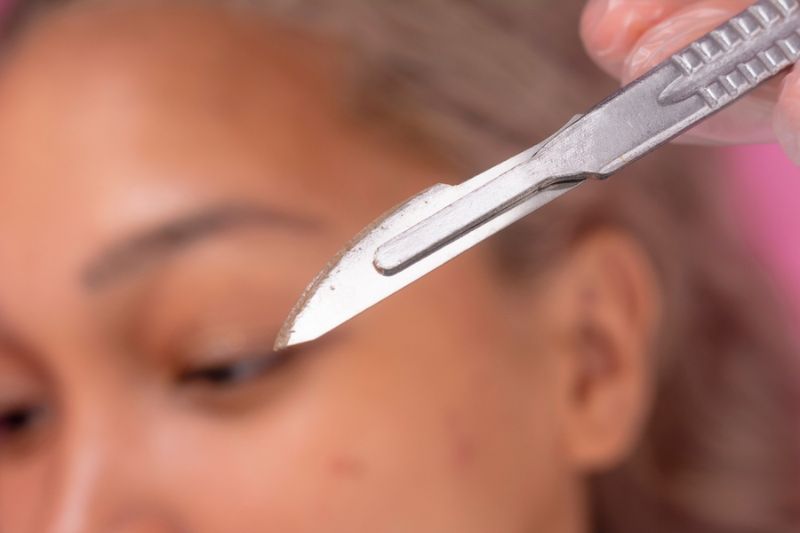
In the rapidly evolving skincare world, estheticians are always looking for the most effective tools to deliver exceptional results. One of the most sought-after techniques for achieving smooth, radiant skin is dermaplaning. This procedure involves gentle skin exfoliation using a precise blade to remove dead skin cells and fine vellus hair, also known as “peach fuzz.” Having the right professional dermaplaning tool for estheticians is crucial to ensure superior outcomes.
This comprehensive guide explores everything you need to know about dermaplaning tools—what to look for in a tool, how to use it effectively, safety tips, and recommended products to elevate your practice.
Why Dermaplaning is Essential for Modern Estheticians?
Dermaplaning has become a cornerstone service in many skincare clinics and spas due to its numerous benefits:
- Exfoliation: Removes dead skin cells to reveal a smoother, brighter complexion.
- Product Absorption: Enhances the skin’s ability to absorb serums and moisturizers.
- Makeup Application: Creates a flawless canvas for makeup application.
- Instant Results: Provides immediate improvement in skin texture and tone.
- Minimally Invasive: Offers a safe and comfortable experience for most skin types.
Given the growing demand for this treatment, selecting the best professional dermaplaning tool for estheticians is key to meeting client expectations.
What to Look for in a Professional Dermaplaning Tool?
When choosing the ideal dermaplaning tool, several factors must be considered to ensure both client safety and treatment efficacy.
1. Blade Quality and Material
A high-quality blade is essential for precise exfoliation. Look for blades made of medical-grade stainless steel, as they are durable, sharp, and less prone to corrosion.
2. Ergonomic Design
Comfort is critical for estheticians who perform multiple treatments daily. Choose a tool with an ergonomic handle that allows for a secure grip and reduces hand fatigue.
3. Safety Features
Many professional tools include safety guards to prevent accidental nicks and cuts. These are particularly beneficial for less experienced users.
4. Disposable vs. Reusable Blades
Disposable Blades: Ensure hygiene and reduce the risk of cross-contamination. They are also convenient for busy practices.
Reusable Blades: More environmentally friendly and cost-effective in the long run, provided they are properly sanitized.
5. Adjustable Settings
Some advanced tools allow you to adjust the blade’s angle and depth, providing greater flexibility for different skin types and treatment areas.
Top Professional Dermaplaning Tools for Estheticians
1. Dermaplaning Handle with Disposable Blades
These classic tools offer precision and convenience, making them popular among estheticians. Brands like Dermaplane Pro and Swann Morton are known for their reliable, high-quality products.
2. Electric Dermaplaning Devices
Electric dermaplaning tools are ideal for estheticians seeking to streamline their treatments. These devices often come with multiple speed settings and built-in safety features.
3. Multifunctional Skincare Tools
Some dermaplaning tools are part of multi-use devices that offer additional functions like ultrasonic exfoliation and LED therapy, making them versatile additions to your skincare arsenal.
How to Use a Professional Dermaplaning Tool Safely
Safety and technique are paramount when performing dermaplaning treatments. Here are step-by-step guidelines to ensure optimal results and client satisfaction.
1. Prepare the Skin
Cleanse the skin thoroughly to remove makeup, oil, and impurities.
Apply a gentle alcohol-free toner to ensure the skin is dry and free of residue.
2. Position the Tool Correctly
Hold the dermaplaning tool at a 45-degree angle to the skin. This angle allows for effective exfoliation without irritation.
3. Perform the Treatment
Use short, light strokes to gently scrape away dead skin cells and peach fuzz.
Work in sections, starting from the forehead and moving downward to the cheeks and chin.
Avoid sensitive areas like the eyelids.
4. Post-Treatment Care
Apply a soothing serum or moisturizer to calm the skin.
Educate clients on the importance of sun protection following the treatment.
Common Mistakes to Avoid
1. Applying Too Much Pressure
Excessive pressure can cause irritation or even micro-tears in the skin. Always use a gentle hand.
2. Skipping Hygiene Protocols
Always use sterilized tools and disposable gloves to maintain a clean and safe treatment environment.
3. Dermaplaning Over Active Acne
Avoid dermaplaning over inflamed or broken skin, as this can spread bacteria and exacerbate acne.
Enhancing Client Experience with Dermaplaning
To stand out as an expert in dermaplaning, it’s essential to create a positive client experience. Here are a few tips:
- Personalized Consultations: Understand each client’s skin type and concerns to tailor the treatment.
- Add-On Treatments: Offer complementary services such as hydrating masks or light therapy to enhance results.
- Educate Clients: Explain the benefits of dermaplaning and provide aftercare tips to build trust and loyalty.
Training and Certification
For estheticians, obtaining proper training and certification in dermaplaning ensures not only client safety but also professional credibility. Many reputable skincare institutions offer comprehensive dermaplaning courses that cover anatomy, technique, safety, and client management.
Maintaining and Sanitizing Dermaplaning Tools
Proper maintenance of your dermaplaning tools is essential for longevity and hygiene.
1. Cleaning Reusable Tools
Wash the tool with warm water and a mild detergent.
Disinfect with a medical-grade solution to eliminate bacteria and viruses.
2. Storing Tools
Store dermaplaning tools in a clean, dry environment to prevent contamination and blade corrosion.
The Future of Dermaplaning
As skincare technology advances, the demand for innovative dermaplaning tools continues to grow. Tools with smart features, such as built-in sensors to monitor pressure and skin conditions, are on the horizon. Staying updated with these advancements will help estheticians remain at the forefront of the industry.
Conclusion
Investing in the right professional dermaplaning tool for estheticians is crucial for delivering outstanding skincare results. By considering factors such as blade quality, ergonomic design, and safety features, estheticians can elevate their practice and build lasting client relationships. With proper training, technique, and maintenance, dermaplaning will continue to be a valuable service in the ever-expanding skincare industry.
Whether you are a seasoned professional or just starting your journey as an esthetician, having a high-quality dermaplaning tool in your kit will set you apart. Choose wisely, practice diligently, and watch your client satisfaction soar.





Leave a Reply